Updated: May 2004
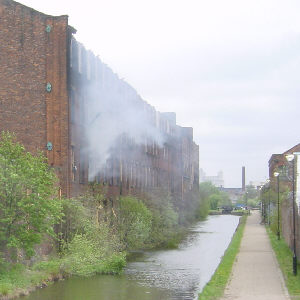
The mill still smouldering after the fire. The wall alongside the canal is unsupported and bowing outwards after the internal floors collapsed.
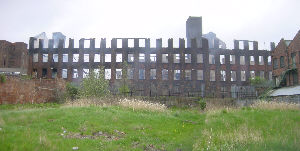
The mill from across the canal after the fire.
The Ashton Canal has been re-opened between Lock 3 and Lock 4 in Ancoats, Manchester, on Tuesday 18th May, after being shut for three weeks.
In the early hours of Tuesday morning (27th April 2004), a fire destroyed the derelict Victoria Mill in Pollard Street, Ancoats, which stood alongside the Ashton Canal between Locks 3 and 4. The roof and internal floors of the building collapsed and the 4-storey wall adjoining the canal was bowing outwards and in danger of collapsing into the canal.
The building had to be demolished from the Pollard Street side, as access could not be gained from the canal.
The work took two weeks, during which time the canal remained closed. The pound between Locks 3 and 4 was drained so that it could be seen whether any debris fell into the canal.
The canal was re-opened at 9.00 am on Tuesday 18th May.
The closure affected boaters navigating the Cheshire Ring and the South Pennine Ring. Boaters were being turned around at Lock 18, Ashton Canal, or at Castlefield Basin or Piccadilly Basin, Manchester.
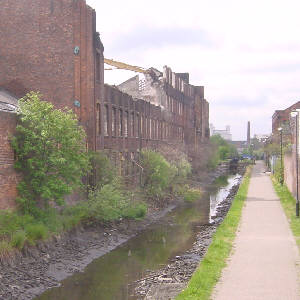
Victoria Mill during demolition.
April 2004
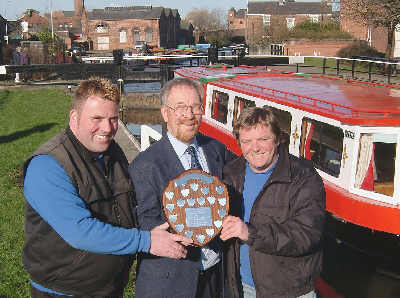
A British Waterways' lock team working the Wigan flight has been voted the best in the country by the organisation that represents professional boaters.
The Association of Pleasure Craft Operators (APCO), which run hotel boats, has made the award for the team's 'outstanding service throughout the preceding year'.
Three full-time operatives, supported by an additional three-man relief, assist customers travelling up and down the 21-lock flight between Wigan Pier and New Springs.
"The restored route is now an attraction that is enjoyed by walkers, boaters and many other diverse groups."
It's the first time that the Lock Keeper of the Year award, which has been bestowed for nearly ten years, has been made in the North West.
Robin Smithett, APCO chairman, said that the team should be justly proud of the recognition, as his members are some of the most widely travelled boaters on the system.
"We received nominations for a large number of waterways but overall it was the Wigan team that were the clear winners.
"Quotes we received included 'they're always helpful and efficient', 'they perform their duties with humour, and make sure boaters have an enjoyable experience on the flight' and 'they make a hard task navigating a very long flight of locks much easier'."
The lock flight at Wigan is a mile and a half long, climbing 167 feet.
The full time team are: Charlie Wilcox, Pat Keane and Paul Abram. The relief team are Steve Priestley, Eddie Peet and Mike Green.
(Photo courtesy of British Waterways)
September 2004
Hopes of restoring the Manchester, Bolton and Bury Canal have moved a step closer with a grant of £300,000 from the Department of Transport, Local Government and the Regions, announced at the end of September.
The final section of the Manchester and Salford Inner Relief Road, due to be built shortly, will run parallel to the River Irwell, crossing the Manchester. Bolton and Bury Canal a few yards from its southern end, close to Prince's Bridge. The new road would have completely cut off the canal but the extra money will pay for the additional work needed to protect the route of the canal.
The work involves driving a row of piles along each side of the canal route, with a concrete slab forming a roof across the route. The road will will constructed above that. At a future date, the ground between the rows of piles can be excavated, forming a tunnel for the canal.
Dave Fletcher, head of British Waterways, praised the decision, saying: "The Government recognises that road building schemes should not threaten viable canal restoration projects and today's decision is a crucial milestone - this news shows that the theory is being put into practice.
Head of British Waterways' north-west area, Derek Cochrane, stated: "I am delighted that the Government is supporting Manchester's canals in this way. We believe that restoring this historic waterway will act as an important catalyst for further regeneration in Salford, Bolton and Bury.
"This is the start of a new era for the canal which has the potential to bring a new identity and quality to central Salford and the Chapel Street area, attracting new investment, generating jobs and creating a wonderful environment for local communities.
"This news is a tribute to all those who have been working so hard to restore the Manchester, Bolton & Bury to its former glory."
July 2004
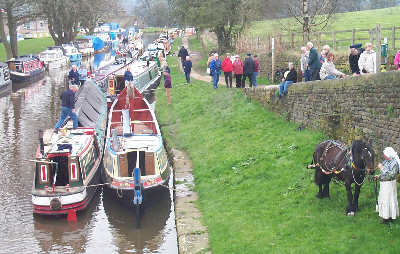
In July 2004 there was a celebration to mark the 200th anniversary of the opening of the Marple flight of locks in 1804.
The Marple locks link the Upper and Lower Peak Forest Canals, which had been open since 1800 but had been linked by a tramway.
The celebration of this anniversary took place along the lock flight and in Marple Memorial Park. Events included a re-enactment of Samuel Oldknow's inaugural trip down the locks, using the Ashton Packet Boat Company's horsedrawn boat "Maria", 150 years old in 2004 and one of the only surviving working boats from the Peak Forest Canal.
Over the Easter weekend (April 9th -12th) there was a gathering of boats above Marple Top Lock to celebrate 30 years of the restoration of the Marple Locks and 30 years of the Cheshire Ring. The wooden Maria was horse-drawn from its Ashton base to celebrate being 150 year old! In readiness for this anniversary, Maria has been restored to its original condition by her owners, the Ashton Packet Boat Company, with the removal of the roof that was added when the boat was converted for carrying passengers. Maria was built at Jinks' yard, next to Marple Top Lock in 1854 and is thought to have been named after Mr Jinks' daughter.
Photo: Some of the boats gathered at Marple, with Maria in the foreground. (Photo courtesy of British Waterways)
Trans-Atlantic Narrowboat in Manchester!
June2004
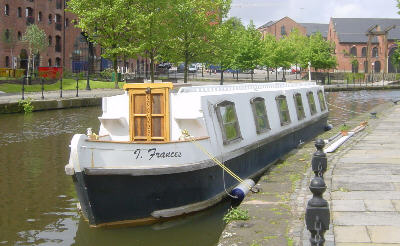
I. Frances at Castlefield.
An unusual narrowboat called at Castlefield Basin on the Bridgewater Canal in Manchester at the beginning of June 2004. The narrowboat "I. Frances" is a little unusual in appearance but does not seem remarkable. What is remarkable is that the boat started its journey in Canada!
The boat was designed by former lecturer in Naval Architecture, Bryan Crutcher. He set himself an ambition of getting from Canada to Moscow, using a combination of ocean and inland waterways. As the narrow canals in England are the narrowest along his intended route, he designed the 57 feet long boat so that it would fit them. It has a mast and sails (for crossing open seas) that can be removed while on inland waterways. It also has a shallow full length keel for stability at sea.
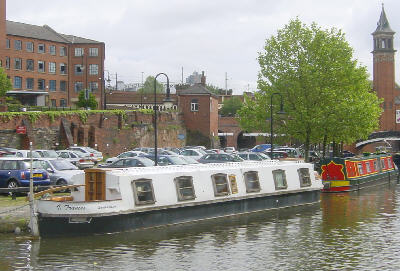
I. Frances at Castlefield.
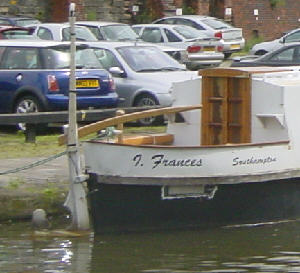
I. Frances - detail of rudder and tiller.
The voyage began at Holyrood, Newfoundland. While crossing the northern Atlantic, the crew of six had to put up with winds of up to 50 knots, waves of up to 5 metres crashing over the roof and, for a few days, winds blowing in the wrong direction, taking them back towards Newfoundland! Five weeks later, they reached the coast of Ireland and sailed up the mouth of the River Shannon to Kilrush, where the boat spent the winter. The following summer was spent touring the Irish canals and rivers.
The boat then sailed across from Dublin to Holyhead, where it over-wintered before heading to Liverpool, travelling along the Leeds and Liverpool Canal and Bridgewater Canal to Manchester. The crew hope to traverse the Huddersfield Narrow Canal and visit Leeds on the next leg of their journey, returning along the Leeds and Liverpool Canal. They intend to spend several years touring the English canal and river system before crossing to the continent, where they will travel the canals of France, Belgium, Holland and Germany on their way to Russia.
For more about the trans-Atlantic journey of I. Frances, click here.
With acknowledgement to Brian Goggin and Bob Holmes.
Updated April 2004
The Rochdale Canal has been re-opened to through traffic after being blocked by a landslip near Hebden Bridge.
After the extremely heavy rain that fell in the area during the first week of February 2004, a landslip occurred on the southern bank of the Rochdale Canal to the west of HebdenBridge. The slippage occurred above Lock 13 (Callis Lock), east of Burntacres Bridge.

The landslip near Callis Lock.
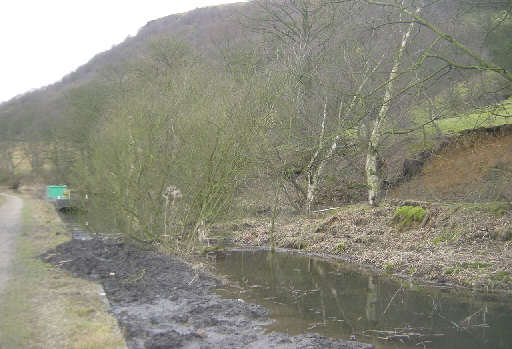
The bank that slipped was on the offside, with a grassy hillside rising steeply above. The weight of water in the ground appears to have caused it to collapse into the canal, taking with it some mature trees and completely blocking the canal.
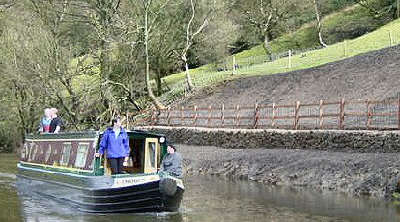
A boat passes the scene of the slippage after repairs are complete. Photo: British Waterways
Mike Marshall, Maintenance Manager said, in 23 years with British Waterways, it was the biggest land slip he had ever seen.
It was estimated that more than 1000 tonnes of earth and vegetation had gone into the canal.
British Waterways' began work to stabilise the embankment on 2nd March. A temporary road was constructed to provide access to the slip site for plant equipment. The area was fenced off to make it safe.
A retaining wall was built to stabilise the bank and drainage channels added. A wall of gabions (rock-filled steel cages) was constructed and the earth built up behind. A lagoon was created for the surplus wet earth to dry out before being taken off site, this being the most cost-effective method. The cost of the repair works was £250,000.
These works took 5 weeks to complete and the canal re-opened for navigation on schedule on 8th April 2004.
April 2004
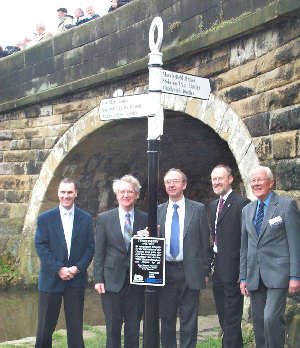
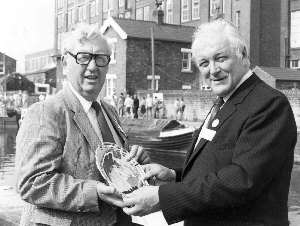
On Good Friday, 9th April, the unveiling took place of a locally-made cast iron signpost to commemorate the work of Ted Keaveney, a local canal enthusiast, who was instrumental in getting the 16-lock flight reopened in 1974.
About 150 people from the boating and local communities attended.
The IWA's North West Region Chairman Margaret Fletcher said:
"Ted Keaveney and the other stalwarts of the Peak Forest Canal Society led the campaign for the restoration of the canal route from Marple to Manchester. To achieve this they did much of the restoration work themselves.
"The restored route is now an attraction that is enjoyed by walkers, boaters and many other diverse groups."
Ted Keaveney's son, Bob, said:
"I am moved that my late father's efforts in promoting waterway preservation, restoration and development, both locally and nationally, are being recognised in this way.
"Its location at Marple Junction is especially appropriate as it was one of my parents' favourite places on the waterway system."
Photos:
Top = Left to right: Adrian Sains, Andrew Stunell MP, Bob Keaveney (son of Ted), John Fletcher (National Chairman, Inland Waterways Association), Tim Dawson (Chairman, Macclesfield Canal Society)
(Photo courtesy of British Waterways)
Bottom - Ted Keaveney (left), receiving an IWA award from BW Area Engineer, John Freeman, at an event in
Wigan, early 80s.
(Photo courtesy of British Waterways)